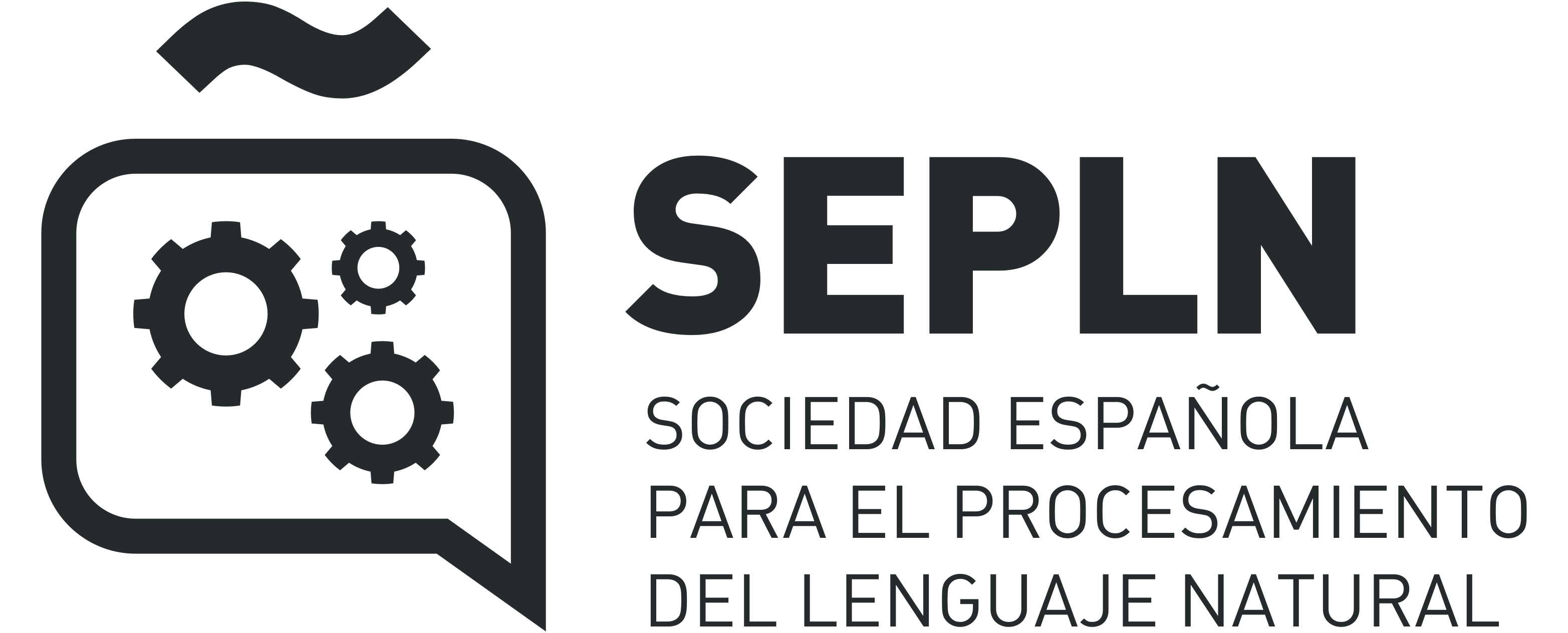
SEPLN 2023: SEPLN 2023: 39th INTERNATIONAL CONFERENCE OF THE SPANISH SOCIETY FOR NATURAL LANGUAGE PROCESSING
September 27th-29th, 2023
Jaén, Spain
The Spanish Society for Natural Language Processing (SEPLN) is pleased to invite you to participate in the 39th edition of the SEPLN Conference.
The huge amount of digital information available in different languages has created the need for systems to access this valuable resource in an increasingly structured way. Thus, there is a renewed interest in improving the ways in which we can access and leverage this information in multilingual environments. The formal and technological foundations to address these needs have and keep being proposed from the area of Natural Language Processing (NLP) and its many branches: information extraction and retrieval, language models, question answering, machine translation, automatic analysis of textual content, text summarization, text simplification, text generation, and speech recognition and synthesis.
The main aim of the SEPLN 2023 Conference is to provide both to the scientific community and to the industry a forum where the latest research and developments in the field of NLP can be presented and shared. The SEPLN 2023 Conference also gives the possibility to present real NLP applications and R&D projects. Finally, the conference intends to be an appropriate forum for helping new professionals to become active members in this field.
Topics of interest
Researchers and NLP engineers are encouraged to send scientific contributions, project abstracts or demos on topics related to NLP, including but not limited to:
- Linguistic, mathematical and psycholinguistic models of language.
- Machine learning in NLP.
- Computational lexicography and terminology.
- Corpus linguistics.
- Development of linguistic resources and tools.
- Morphological and syntactic analysis.
- Semantics, pragmatics and discourse.
- Word sense disambiguation.
- Monolingual and multilingual text generation.
- Machine translation.
- Knowledge and common sense.
- Multimodality.
- Spoken language processing.
- Dialogue systems and interactive systems / Conversational assistants.
- Multimedia indexing and retrieval.
- Monolingual and multilingual information extraction and retrieval.
- Question answering systems.
- Evaluation of NLP systems.
- Automatic textual content analysis.
- Sentiment analysis and argument mining.
- Plagiarism detection.
- Negation and speculation processing.
- Text mining in social media.
- Text summarization.
- Text simplification.
- NLP in the biomedical domain.
- NLP-based generation of teaching resources.
- NLP for languages with limited resources.
- NLP industrial applications.
- Low-resource NLP tasks, data augmentation.
- Ethics and NLP.
- Interpretability and Analysis of Models for NLP.
Structure of the Conference
The SEPLN 2023 Conference will be a three-day event and will include sessions to present papers, ongoing research projects and prototype or product demos related to the topics of the conference. Likewise, the 26th of September will take place the Workshop Day, where the main workshop will be IberLEF 2023.
Paper types and author guidelines
The SEPLN 2023 Conference will accept three kinds of papers: (1) scientific contributions, (2) research project summaries and (3) system demonstration papers.
Scientific contributions. The accepted scientific contributions will be published in the Journal Procesamiento del Lenguaje Natural, whose aim is to promote the development of areas related to NLP, disseminate research carried out, identify future guidelines for basic research, and present software applications in this field. The scientific quality of the Journal is supported by the 2021 JCR index (JCI: 0.21, Q4-Linguistics - ESCI), the SCImago Journal Ranking (SJR: 0.217, Q4-Computer Science Applications, Q2-Linguistics and Language), the Scopus Index (CiteScore: 1.5, Q4-Computer Science Applications, Q2-Linguistics and Language) and the index SNIP (Source Normalized Impact per Paper) with 0.37 points. More information at http://www.sepln.org/en/journal/quality.
The papers can be written in Spanish or English and must be at most 10 A4-size pages of content, plus unlimited pages for references. The papers must include the following sections:
- The title of the communication (in English and Spanish).
- The paper must be anonymized, since the Journal follows a double-blind review process.
- An abstract with a maximum of 150 words (in English and Spanish).
- A list of keywords or related topics (in English and Spanish).
- The documents must not include headers or footers.
The information about all the details of the format of the papers and the Latex and Microsoft Word template are at: http://www.sepln.org/en/journal/author-guidelines.
Camera ready - the final version of the paper (camera ready) should be submitted together with a cover letter explaining how the suggestions of the reviewers were implemented in the final version. This cover letter will be considered in order to accept or finally reject the selected paper.
Preprint policy - The Journal allows the publication of preprints (non-refereed paper posted online, such as ArXiv) anytime, but during the review period the preprint must indicate that the paper is “under review” in the Journal Procesamiento del Lenguaje Natural. Likewise, if the paper is accepted, the preprint must be updated with the DOI, name of the Journal and the bibliographic information of the paper.
Research project summaries. They are summaries of ongoing research projects. This kind of papers must include the following information:
- Project title.
- Author name, affiliation and contact information. The review of this kind of paper is not blind review.
- Funding institutions.
- Research Groups participating in the project.
- Language: English. We will not accept research project summaries in Spanish or other languages.
- An abstract of a maximum of 150 words and a list of keywords.
- Minimum length: 5 pages.
- Maximum length: 6 pages (including references).
In the submission platform you have to choose “Projects and Demos” as main topic.
System demonstration papers. These papers must be related to NLP applications, and they must describe the technical details and the NLP components used or developed. The paper must be written in English, the minimum length of the paper must be 5 A4-size pages and the maximum length is 6 A4-size pages of content with the references included.
In the submission platform you have to choose “Projects and Demos” as main topic.
The research project summaries and the system demonstration papers will be published in CEUR Workshop Proceedings platform, which is widely known by the computer science research community. Accordingly, the paper format must match the CEUR template. We have adapted the CEUR Latex Template to SEPLN 2023 and you can download it here.
Submission Information. The papers must be submitted by March 31st, 2023. All submissions must be in PDF format and submitted electronically using the MyReview system available at: http://myreview.sepln.org/myreview-sepln71.
Submitted papers will be subjected to a blind review by at least three members of the SEPLN advisory council.
Important dates
- Deadline for the submission of papers, projects and demos: March 31st, 2023.
- Notification of acceptance: May 16th, 2023.
- Camera Ready: May 31st, 2023.
- Workshops: September 26th, 2023.
- Conference: September 27th-29th, 2023.
Contact
All information related to the conference can be found at http://sepln2023.sepln.org/.





